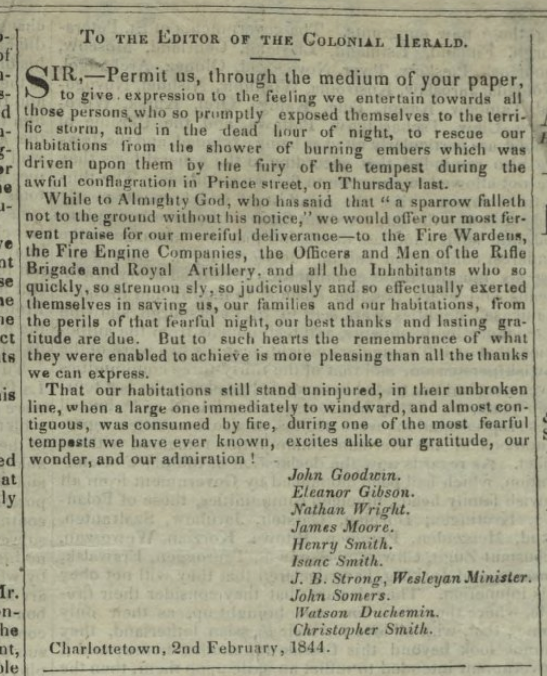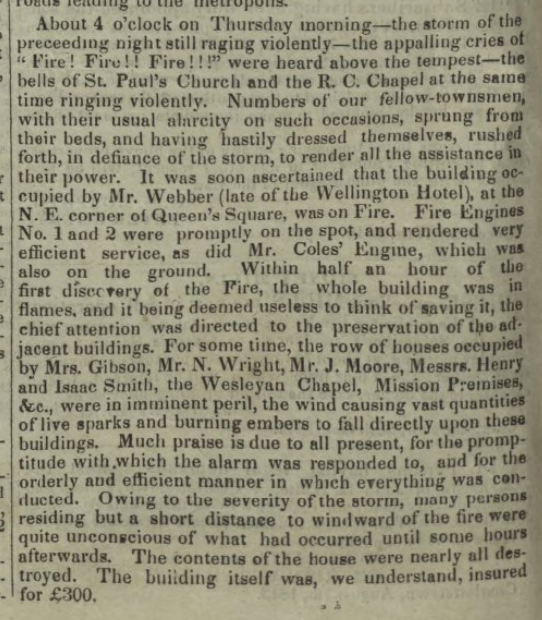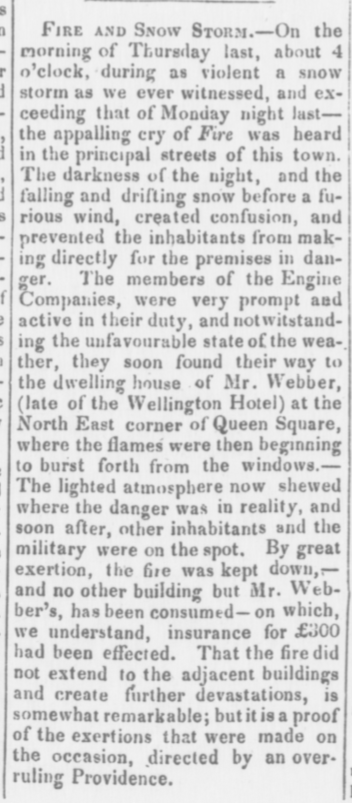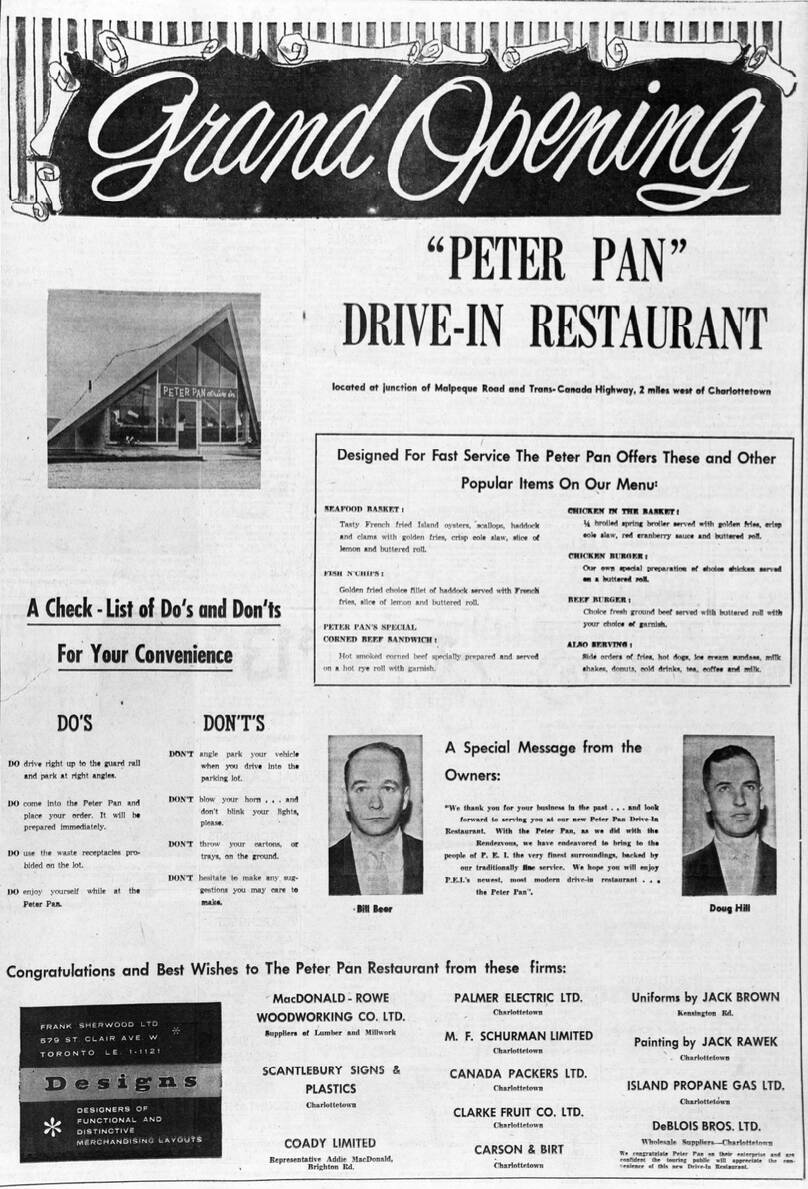Every day at 1:30 p.m. and 5:00 p.m., Dr. Heather Morrison, Prince Edward Island’s Chief Public Health Officer, provides a a live briefing to Islanders about COVID-19.
In this time of great uncertainty, with a plague spreading across the land and, all signs suggest, about to reach our shores in a more serious fashion, it’s hard to imagine a better figure to have hands on the tiller, both the logistical tiller, and the spiritual one.
And so while the Premier, in isolation due an unfortunately-timed family vacation to Boston, dials in from Skylab, and his ministers dutifully read their press releases about the supports their line departments are enacting, it is Dr. Morrison who’s the beating heart of the operation, and we are all the better for it.

From the Colonial Herald, February 3, 1844, a letter to the editor from the residents of Prince Street:

The fire to which the correspondents refer took place the previous day, in the middle of a snow storm on February 1, 1844, and was reported earlier in the same edition of the newspaper:

The day’s edition of the Morning News and Semi-Weekly Advertiser also reported on the file:

Our house was one of the row of houses referred to as having been in peril, the one occupied by Henry Smith; as with the others on this row, it emerged uninjured. Like the writers of the day, this excites alike my gratitude, my wonder and my admiration.
Haunts, a 2013 EP from New Zealand’s Tiny Ruins, is a good way to remind yourself about why music is a good thing.
A collection of older songs/B-sides. Recorded live in the bush surroundings of the Waipu Gorge, by Jonathan Pearce on an 8-track tape machine.
Days Are Long, Nights Are Longer and Always You, Tiptoeing Through are my favourite tracks.
Tiny Ruins’ spring tour of France has been cancelled, so why not buy some recordings in solidarity.
Author and illustrator Mo Willems is doodling every day at lunchtime on YouTube, under the aegis of his “Artist in Residence at Home” at the Kennedy Center:
Learners worldwide can draw, doodle and explore new ways of writing by visiting Mo’s studio virtually once a day for the next few weeks. Grab some paper and pencils, pens, or crayons and join Mo to explore ways of writing and making together.
Rather than completely cancelling our monthly Pen Night here in Charlottetown, we’re moving it into the clouds, via Zoom videoconference.
This is an experiment, as we’ve no idea if what works about Pen Night around a table will also work for Pen Night on the screen. If nothing else it will give us a chance to de-social-distance on a Saturday night.
While details will go our to the regular Pen Night mailing list that Dan at The Bookmark maintains, that this is virtual provides the option for special guest stars from away; if you’d like to join out virtual table on Saturday night at 7:00 p.m. Atlantic, please drop me a line and I’ll send you an invite. All you need is an interest in fountain pens; no experience necessary, you need not be hip to the arcane lingo, and you will find welcoming, kind people.
I was reminded last night that SARS touched Prince Edward Island in 2003 to the extent that I wrote about it here, and to the extent that the Chief Public Health Officer was issuing advisories about self-isolation for returning travelers. How quickly we forget.
This time around, with COVID-19, things are considerably escalated.
For our family, most prominently this means that the Stars for Life day program is suspending as of tomorrow, leaving Oliver to be at home for his days; fortunately, as he and I were ill last week (with a bonus non-COVID-19 illness, from which we’ve now both recovered), we’ve got a routine down, and our daily life will continue without much calamitous disruption.
Our pantry is well-stocked. It turns out that I’ve been hoarding tempeh for months now, so we’ve got enough soy protein to last us for a long time. I found out on the weekend that Purity Dairy not only sells its own milk and ADL butter, but also yogurt, meaning that with the dry goods we have already, and a weekly walk to Purity, we can likely make do without going to a larger grocery store for some time.
I’ve been a “remote worker” since 1996, so not only am I well-versed in it, but my remote colleagues and I are several hundred iterations into fine-tuning our remote workflow. The NHL may be cancelled, but Almanac.com will continue to hum along for all your “will the sun come up tomorrow?” needs.
Meanwhile, I’ve taken the morning to #CancelEverything: upcoming face-to-face meetings are either rescheduled for “when life returns to normal” or moved to virtual meetings via Zoom. The best advice seems to be that its prudent not only to avoid large groups, but to avoid cross-contaminating family groups, so even a dinner party with friends is no longer benign; that takes some getting used to, and involves a change in social protocols.
I realized that, as regards the world going to hell and people dying, I have a particular set of hard-wrought skills in this regard.
Here’s my best advice for you, a gift from Catherine, really, as it distills how she dealt with her uncertain times:
Ask yourself “right now, here, am I alive?”
If the answer is “yes,” then continue.
Friend of the blog, and Artistic Director of Norristown, Pennsylvania’s Theatre Horizon, Nell Bang-Jensen, in a video release this week:
As you can imagine, the idea of social distancing is very challenging for an arts organization whose whole mission is about bringing people together, in the same space, in the name of our shared humanity.
I don’t particularly care if COVID-19 means the end of professional sports, the stock market, the airlines, or capitalism; I do, however, want organizations like Nell’s to survive.
As Jamie Zawinski wrote about DNA Lounge in San Francisco:
Even though we’re closed, meaning that we have lost 100% of our income, we still have a lot of expenses that are not going away: rent, insurance, taxes, permit fees… We’re also still paying our employees while we’re closed. Depending on how long this crisis lasts, this could end up leaving us on the hook for hundreds of thousands of dollars.
The same thing could be written by anyone who manages a theatre or gallery or workshop.
You don’t need to leave your house to help in the life support effort for the arts: find a way to make a donation online (donate to Theatre Horizon here; DNA Lounge has a Patreon).
Think of all the money you’re saving not eating out, not going to the movies, not buying theatre tickets: take that, and lend a hand.
Danny Gregory writes, in part, in Hope to cope:
Worry is an obsessive series of thoughts that needs to be diverted. Stress is a body thing that needs to be purged like bad sushi. But you can’t just think your way out of Anxiety. You need distractions that have a physical component. The New York Times suggests listening to music, skipping rope or rubbing velcro.
I have another remedy.
I open my sketchbook, uncap my pen.
Drawing is a mental and a physical activity.
It drags me off the obsessive carousel of worry and puts me into physical action. It breaks the spell and gives me a job.
Drawing diverts and slows down my overstimulated imagination and it anchors me in the Now. The Taser effects of stress start to wash out of my system. Adrenaline and cortisol get filtered away. My heart slows. My breathing normalizes. I get perspective on what I’m drawing and on what is roiling my mind.
I’ve found sketching to be very helpful, in exactly the way he describes.
Even more helpful that that are the words of Mark Rice-Oxley in The Guardian:
The most annoying question news anchors ask their correspondents is: “How worried should we be?” Not just because worry is hard to quantify (“er, very”?); not just because it’s a leading question.
But because the answer should always be: “We shouldn’t worry at all. Worry is pointless. There is bound to be something better that we can do.”
Indeed, psychotherapists might go on to say that if we are eaten up with worry, we should ask ourselves about the worrisome thoughts we are having: are they actually true? And are they helpful to us? If the answer to either is no, then worry is not serving us well.
It’s perhaps naive to simply say that we shouldn’t worry because worrying isn’t helpful: it were only that easy.
But I’ve found it uncommonly useful regardless.
Even though in the years since I last wrote about it, I’ve become a vegetarian, I’d always entertained hopes that the much-vaunted Peter Pan restaurant, on the Peter Pan corner, would be resurrected.
But, with the news that it’s fallen to the wrecker’s ball, those hopes are dashed.
Catherine and I enjoyed a lot of Peter Pan Burger Baskets and milkshakes in that parking lot over the years.
Here’s the ad in The Guardian from from June 26, 1958 announcing the Grand Opening:

 I am
I am